The Remarkable Impact of the Deep Tunnel
Once widely maligned, the project was the key to transforming the Milwaukee River.
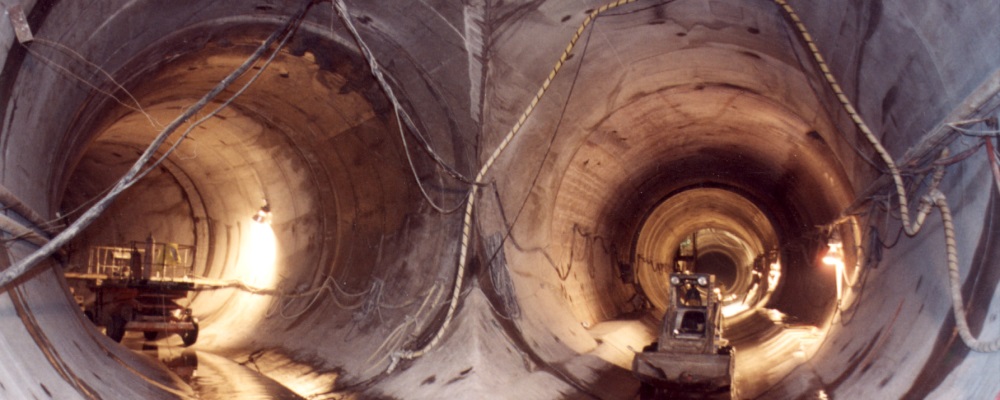
Inside the Deep Tunnel. Photo courtesy of MMSD.
This week the Milwaukee Journal Sentinel published an excellent series, “Rivers Reborn,” on the impact of having cleaner rivers in the Greater Milwaukee region. A story by Tom Daykin noted that “the total fair market value of riverfront properties between North Ave. and the Milwaukee harbor increased by nearly 150% from 2001 through 2013…That added more than $520 million in value.” During that same period, he noted, the total value of all Milwaukee properties increased by just 44 percent.
The creation of the RiverWalk under Mayor John Norquist was a key factor in that development, but it would have been for naught if the once filthy river hadn’t first been cleaned up. And the number one factor transforming the river, as a sidebar written by JS environmental reporter Don Behm concluded, was the building of the Deep Tunnel. “After the tunnel was completed, there were immediate gains in water quality in the waterways flowing through central Milwaukee… At the time, combined sanitary and storm sewers in central Milwaukee and eastern Shorewood overflowed each time more than one-quarter of an inch of rain fell — up to 60 times a year. The overflows sent sewage with heavy loads of bacteria into the rivers.” But after the Deep Tunnel was built the sewer overflows dropped from nearly 60 a year to an average of 2.4 overflows, Behm notes.
A 2007 study with data from the Southeastern Wisconsin Regional Planning Commission showed that prior to the Deep Tunnel’s creation, “point pollution” mostly caused by sewer overflows (and partly by industrial discharges) was the main cause of regional water pollution, but after the Deep Tunnel, point pollution dropped to causing just 9 percent of the problem. Non-point pollution had now become the major, remaining source of pollution, causing about 90 percent of the region’s problems. These are mostly “pollutants washed off the landscape in storms,” as Behm writes, including “bacteria from birds and animals, dirt and salt from streets and parking lots, vehicle fluids, fertilizers and pesticides.”
Such non-point pollution is tougher to reduce because it greatly depends on residents in the region changing their behavior, reducing their use of lawn and garden fertilizers, salt on sidewalks and driveways, or cars that leak oil and other fluids, all of which gets swept into the rivers during rainstorms. Residents can also reduce the amount of storm water runoff by using rain barrels or installing permeable pavement.
When in fact it was a nationally notable success. “Most cities would kill to have the system Milwaukee has. I know I would,” said Don Theiler, then head of the King County Wastewater Treatment Division in Seattle, in a 2007 interview for a Milwaukee Magazine story I wrote.
But Sykes and Belling couldn’t have propagated their wildly inaccurate message if not for the Milwaukee Journal Sentinel, which for many years ran screaming front-page headlines about sewage being dumped into the lake, without ever making it clear how rare this was — or how much the situation had changed in Milwaukee. In my Milwaukee Magazine column, I had quotes from suburban officials blasting the JS and talk radio for misleading the public.
Professors Erika T. Jensen and Sandra L. McLellan of the highly touted UW-Milwaukee Great Lakes WATER Institute did a study of media coverage of beach closings, and found that over a five-year period, the Journal Sentinel did 19 stories blaming sewer overflows for bacterial contamination of beaches. Not one was true, they concluded. Instead the bacteria came from storm water contaminated with fecal waste from pets and wildlife, particularly sea gulls.
McLellan told me that when she gave talks in town about the true cause of beach closings, audiences overwhelmingly — and wrongly — believed sewer overflows were the culprit. As a Journal Sentinel editorial in 2007 noted, “Due to the constant and often uninformed sniping by talk radio and other critics, many people have mistakenly come to think of the tunnel system as a colossal, obscenely expensive public works failure.”
The editorial, naturally, left out the impact of the newspaper’s own stories. But by then, the paper had begun to make an about-face. The reign of terror against the MMSD, which I suspect was pushed by the newspaper’s managing editor George Stanley, had ended. Behm was assigned to cover the MMSD and all those stories wrongly blaming beach closings on the MMSD ended. However, the current series consigned Behm’s take on the Deep Tunnel’s impact to a small sidebar — clearly an editor’s decision.
Still, the series will definitely help the community understand what is really going on. But there is still a lot of damage to undo. I suspect a survey of regional residents would show many still believe — wrongly — that the Deep Tunnel is a failure and that it — rather than day-to-day decisions by residents — is a major cause of the area’s remaining water pollution. And it’s hard to solve a problem if you don’t understand the true cause of it.
Deep Tunnel Construction
Murphy's Law
-
National Media Discovers Mayor Johnson
 Jul 16th, 2024 by Bruce Murphy
Jul 16th, 2024 by Bruce Murphy
-
Milwaukee Arts Groups in Big Trouble
 Jul 10th, 2024 by Bruce Murphy
Jul 10th, 2024 by Bruce Murphy
-
The Plague of Rising Health Care Costs
 Jul 8th, 2024 by Bruce Murphy
Jul 8th, 2024 by Bruce Murphy


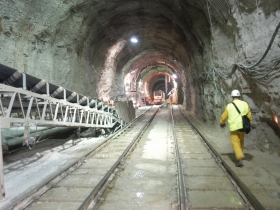
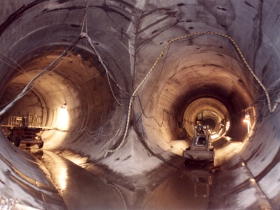
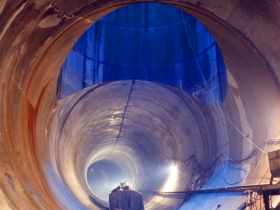
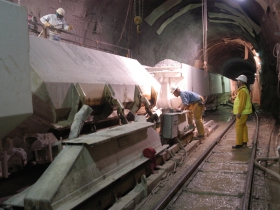

















This is still so frustrating for me. I have friends, mostly in the suburbs, that have no idea how effective the system is. Didn’t this all start with the “Sewer Wars”? The “Sewer Wars” were not about the whether or not we needed the system, but rather how we were going to pay for it. I believe the cost is paid for by property values rather than usage. Since home values in the suburbs are greater, they would pay more per household regardless of usage. This issue gave birth to Sykes and Belling. They started their careers on this issue. Also, I know we’ve dropped from 60+ overflows to 2.4 on average annually, but that does not mean volume of sewage being dumped into waterways dropped by that much. A total volume decrease in gallons annually would be more accurate. And finally, the suburbs need to understand that lack of densiies drive up the costs for infrastructure. Serving one home in Franklin requires more equipment.
David, as to volume, overflows are on average, at about one-ninth the level they were prior to the Deep Tunnel. Still a huge reduction.
Blah, blah, blah, dealing with sewage is the corner stone of civilization. Since the beginning of time getting rid of it has always cost more than was budged for.
Belling and Sykes should would clean up their act. The other corner stone, water, seems to be in short supply
Waukesha, where many of their listeners live.
I concur that a decrease by volume would be a better measure than just the number. Even better, if MMSD could document volume and quality of the releases, say into loading. A million gallon combined sewer release is likely to have a lot less impact than a million gallon sanitary sewer release.
The Journal-Sentinel could also do a better job of describing what’s actually happening when MMSD skips some steps when pumping out the Deep Tunnel. Either a discharge meets effluent standards or it doesn’t. If a discharge meets effluent standards, then reporting on it as other than a success is foolish.
It might also help if we could stop pretending that storm sewer runoff is “clean”.
I do think the city of Milwaukee is starting to take the issue of runoff pretty seriously. And developers are taking note. The Reed Street Yards development is handling and containing all water, returning nothing to the sewer system. They have swales along the river to absorb runoff and are using permeable pavers along the access roads edges. This will allow absorbtion before the water reaches the sewers.Granted, it is the Water Research Park, but they’re showing what can be done.
George Stanley is a rabid republican who shapes every headline you see in the MJS. He is also a rabid Walker supporter.
It just isn’t the deep tunnel – combine the tunnel with all the retention ponds and and the permit requirements to reduce run off has resulted in cleaner rivers and Lake Michigan.
If its not already done, why don’t we simply quantify the per gallon cost of stormwater treatment to include the property benefit, to that of the separating sewers, and of course the deep tunnel. While not overseeing the benefit of green infrastructure, to control water quality while having a single sewer. It’s about the triple bottom line as well….hard to quantify all this but I think its been done by Milwaukee actually.
Outstanding article, Bruce.
The other point that Sykes and Belling ignore is the fact that the deep tunnel was the product of litigation. The City of Chicago sued Milwaukee for polluting Lake Michigan. There was a vigorous debate at the time over the scope of the project as well as whether or not we should separate the system, so that storm runoff was processed differently than sewage. A project could have been designed to eliminate overflow completely, but it would have been significantly more expensive. Sykes and Belling are paid to lie. They produce entertainment, not news.
That’s true. Chicago dumps in the river and sends it along to the Mississippi. I wonder when the Quad Cities will sue. Also, I wonder WCD is. This should be red meat for him.
As reporter for the old Milwaukee Journal who covered water pollution in the 1960s, I knew that Milwaukee and Shorewood’s combined sewers overflowed diluted sewage into the Milwaukee River on average 56 times a year. The frequency was such as to cause newspaper editors to treat them as routine and therefore not newsworthy. Weather stories often pointed out beach closings caused by excessiuve fecal coliform bacteria and feature stories about the Milwaukee River pointed out the chronic pollution loadings emanating from the sewers. But news stories about individual overflows were rare, otherwise there would have been more than a story a week, on average. When the tunnels were built, overflow frequency fell to one or two times a year, rare enough to attract the attention of the press, especially the Journal-Sentinel, which ran exposes under big headlines, even though annual overflow was vastly reduced. Finally, a persistent look at the facts, such as reported by Behm, have educated even editors. Doubtful that Sykes will change however since the deep tunnel “failure” plays so well into his infantile scatology supporting the “deep tunnel award” in which he flushes a toilet on air to heap contempt upon his political target of the week..
I do not recall Belling or Sykes designing this failed system. The fact of the matter is that MMSD has dumped over 11 billion gallons of raw sewage into Lake Michigan in the last 10 years. Only someone who sees MPS as successful could call this anything but a boondoggle. It is insufficient to handle the needs of the city and it is mismanaged. I suggest that all of you who feel it is such a huge success go for a swim in Lake Michigan right after a rainfall of 1″ or more. Our do nothing Mayor actually ran on the promise of eliminating raw sewage dumps back when he still wanted the job of mayor. Over 1.4 billion gallons of sewage was dumped during the first 24 months of his tiresome tenure. 7 of the 11 appointees to the MMSD board were appointed by Barrett and not so coincidentally 6 of them donated significant amounts of money to his campaigns. Blaming the critics of this failure and not the people running it makes no sense at all.
The fact of the matter is the deep tunnel was never designed to bring overflows to 0. The cost to go to 0 by either building a bigger tunnel or separating the remaining sewers (oddly this option probably wouldn’t improve water quality or insure no overflows of sewage [note shorewood] anyhow]), would not receive support from Belling or Sykes anyhow so their knocking of it seems purely political and not practical. The city and MMSD are now working on the real next solutions to solving water quality issues, and these involve green roofs, net zero development, purple pipes, grey water systems and so on. Finally, it quite clearly has dramatically improved the water conditions in Milwaukee, to ignore this is simply ignoring the facts.
PS If we don’t slow the growth of sprawl, we’ll never solve stormwater management.
David (post 11), Chicago’s sewage flows into the Illinois River, so it doesn’t affect the Quad Cities. The Illinois River empties into the Mississippi around St. Louis.
Chris Byhre, you say “MMSD has dumped over 11 billion gallons of raw sewage into Lake Michigan in the last 10 years.” Is it really 11 billion gallons of “raw sewage” or is it 11 billion gallons of “dilluted and/or partially treated sewage”?
I suspect it’s the latter.
Tom D I got my info from a Media Trackers Article from May 30, 2012 where it cites MMSD as admitting to dumping 10.5 billion gallons of “raw sewage” into Lake Michigan since 2004. In the last two years they have dumped millions more gallons of sewage into the lake. Dave Reid, no one said water quality has not improved, but are you really going to celebrate dumping 11 billion gallons in a decade as a success story? We can do a lot better but it won’t happen under current leadership.
No one celebrates combined sewer overflows. However, dramatic improvement to water quality is directly attributable to the deep tunnel system. But the deep tunnel is only part of the solution. It’s really about the health of the watershed and the removal of PCBs in the river beds. We cannot and should not control all the water that falls during rain storms. Protecting the rivers from runoff and allowing the land to absorb and store the water is a more cost effective and environmentally friendly way of dealing with water quality issues.
Media Trackers is cherry picking their end point. If they went back to 2001, or 1994, like they should as that’s when the Deep Tunnel became operational, the yearly average would look much better.
Here’s the data: http://www.mmsd.com/en/wastewatertreatment/Overflows.aspx
I could pick 2011 as a starting point, and MMSD would look much better.
Which should not be seen as giving MMSD as a pass. Heck, we shouldn’t give individual communities a pass either as lack of maintenance is contributing to inflow and infiltration issues. But, dealing with non-point sources, which extends well beyond MMSD, should be getting more attention and MMSD should get credit for the improvements in river quality.
Let’s also note that Belling and Sykes are political commentators, not scientists or engineers. Which is again, not to say that MMSD is beyond critiquing, but Belling and Sykes never talk about practical measures, e-coli counts, sediment concentrations, etc. The fact that the Milwaukee River has improved based on scientific measurements, doesn’t fit their narrative.
Chris Byhre, many people use the term “raw sewage” imprecisely, including the Journal-Sentinel.
For example, the J-S reported that MMSD discharged 4.6 billion gallons of “raw sewage” in May, 2004, alone. This would seem to be physically impossible, since that would require that each of the 1.1 million people served by MMSD produce 135 gallons of “raw sewage” each and every day (typical water use is estimated at 80-100 gallons/day in the US) and would require that MMSD treated no sewage at all that month so that every toilet flowed directly, untreated, into Lake Michigan for at least 31 straight days.
http://www3.jsonline.com/news/metro/oct04/263455.asp?format=print
http://water.usgs.gov/edu/qa-home-percapita.html
Politifact says that the typical MMSD discharge is diluted about 20-to-1 with rainwater which would mean that the 10.5 billion gallons of “raw sewage” you cite is actually “only” 0.5 billion gallons of raw sewage and 10 billion gallons of rainwater.
http://www.politifact.com/wisconsin/statements/2010/sep/03/scott-walker/scott-walker-blames-tom-barrett-dumping-sewage-lak/
And while you complain about 10.5 billion gallons of diluted sewage that MMSD dumped over 8 years, Chicago dumped more than that into Lake Michigan in April, 2014 alone (this is in addition to whatever they dumped into the Illinois River).
http://articles.chicagotribune.com/2013-06-12/news/ct-met-flooding-runoff-20130612_1_green-infrastructure-deep-tunnel-runoff
@Chris Since opening MMSD has treated something like 98% of all water that has entered its system. Yup the deep tunnel is a clear success, but yeah 100% would be better. Can it hit 100% one day? Maybe… though as in lots of things that last bit is where things get more complicated and possibly more expensive. Further, as Tom D points out the vast majority of liquid in these overflows is rainwater. Now I believe if we can clean the rainwater we should, because it picks up heavy metals and such but it isn’t what people think of when terms like “raw sewage” are bantered around. But yeah Media Trackers and talk radio probably don’t make those destinations or point out that the system is just about doing what was promised.
If the overflow comes from combined storm and sanitary sewers and is caused by rain, the effluent has to be diluted sewage.
Bruce Murphy Thanks for providing us with an outstanding article.
I am not as familiar with Milwaukee’s sewer system, but I know in other places where they are addressing the combined sewer overflows, the goal of their projects is to capture just the initial surge of sewage from as much of the system as possible because the initial surge of sewage in a combined sewer system contains most(up-to 90%) of the fecal matter, and household waste. The initial surge in a rain event is caused when the rain water flushes out the initial waste. In a city of Milwaukee’s size it could take a day, or even longer for normal waste to travel from a house to a treatment plant. When it starts raining, the excess water pushes the sewage faster and flushes out the system just like a toilet. A deep tunnel system is designed to capture the initial surge from multiple parts of the city over time which is why you should always hear of them closing part of the tunnel to save room in it for water coming from farther away. It is better for them to capture that first surge of water from across the system and let some outfalls overflow earlier, than to fill up the tunnel, and then dump the initial surge of waste coming from farther away.
I do think it’s worth noting that 9% is not an insignificant number. And there certainly are areas of the system that need addressing. The overflow this year into Lincoln Creek wasn’t because the Deep Tunnel was full, but because sewerage couldn’t get too the Deep Tunnel fast enough / too much stormwater was entering the system near Lincoln Creek. I know MMSD is planning to address that area as part of their 30th Street corridor projects, but those problems with the system are absolutely fair game for criticism.
Also, I think there are only three points to review data from that have any sort of significance to draw conclusions from without cherrypicking data end points. 1. When the Deep Tunnel came on line. 2. When the Northwest Side Deep Tunnel came on line. 3. When the 27th Street Deep Tunnel Extension came on line. Pick a different starting point, and you can be sure that data manipulation is going on.
I’m not clear on your last point of data manipulation and when the tunnels came online. Also, I agree, 9% is not insignificant. It is not beyond critisism. But I do believe that the right wing media has made it a partisan issue and that is why most people are uninformed. They rely on angry listeners with incomplete and twisted information. However, I do believe watershed health is the way to go. I believe ronoff is more of a long term problem than the occaisional overflow.Keeping water out of the system is key to long term success.
My point on data manipulation, is that the Deep Tunnel, even after it was brought on line, has had several notable additions. There’s the original configuration which was brought on line in 1994 which holds about 405 million gallons.
In 2005, the northwest side deep tunnel was brought on line which holds 89 million gallons.
In 2010, MMSD completed the 27th Street deep tunnel extension, which holds another 27 million gallons along with the harbor siphons project and the Canal Street wet weather relief sewer project and called it a day as far as major new sewer projects.
When we talk about the Deep Tunnel it means significantly different things depending on the time frame. From 1994 to 2004 it meant one thing, from 2005 to 2010 it meant another, and from 2011 to present it means something different again. Arguably, when talking about what we should be doing going forward, we should be evaluating from 2011 data onwards because the previous records of overflows aren’t relevant to evaluating the current system.
And when you pick a date other than the starting date when the various parts of the deep tunnel went on line, you are skewing data by excluding relevant data. And excluding relevant data, good or bad, is a sure sign of data manipulation.
I’m sure talk radio extensively covered the Mequon overflow in April: http://www.jsonline.com/news/wisconsin/snow-rain-lead-to-sewer-overflows-in-15-wisconsin-communities-b99250834z1-255799921.html
My goodness, what a mismanaged wastewater treatment plant. I hope heads rolled after that one.
While the deep tunnels gave reduced overflows substantially we still have problems plus we have old sewers in Shorewood/Milwuakee and overflows. Separating the sewers would have given us new street in both cities but Henry Maier pulled power play to make metro area pay for the deep tunnels, just as he did the museum. Now Barrett tried to stick us with tthe electric bill for the choochoo train for Milwaukee.
wonder why no one will ever vote any money for Milwaukee?
WCD. I think its clear that old municiple pipes and private laterals in many towns including Brookfield and Mequon are just as much to blame for soiling our waterways. Thank you JS for finally reporting overflows in our suburban communities. In fact, Brookfield is under an order by the EPA to clean up its act. It doesn’t help that you use every issue to push a conservative agenda. You’re slowly being exposed.
The original “sewer war” was in the early 1900’s when Milwaukee was refusing to permit unincorporated and incorporated areas outside the city to hook up to Milwaukee’s water supply and developing sewerage system unless they agreed to be absorbed into the City. In the late 1970’s and early 1980’s, the second sewer war was about whether all in the regional water/sewer system should pay the cost of separating the storm and sanitary sewers in Shorewood, Milwaukee, and some other older areas, which the suburbs vehemently resisted, led by Milwaukee lawyer Jack Reinhardt, or should be paid for only by the property owners who would be served directly by new sewers. This lead to searches for new ways to deal with the problem at less cost – resulting in the Deep Tunnel project. It is similar to Chicago’s. The question that remains is: would we have better solved the problem at lower overall cost if we had just paid to separate the storm and sanitary sewers in 1982?